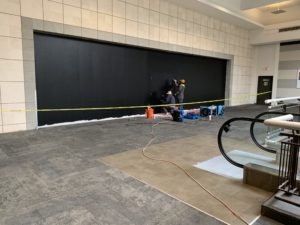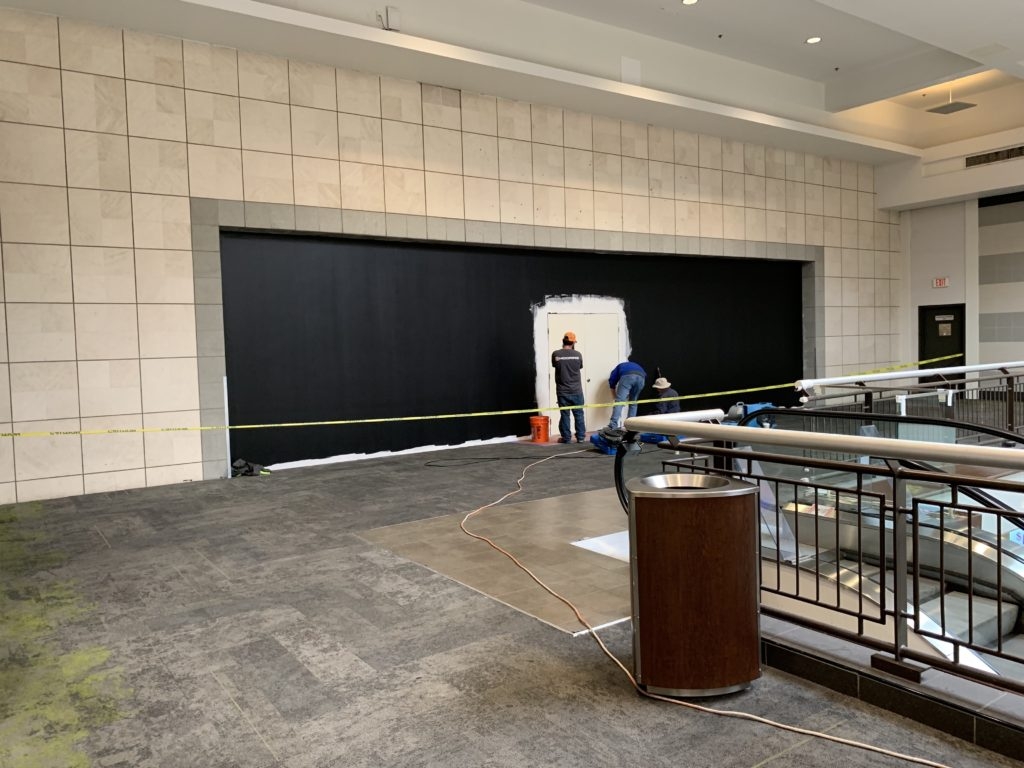Some sights stop you in your tracks. It happened last week at the Barton Creek Mall in Austin. Something caught my eye. An area once occupied by a wide archway had become a solid matte black wall.
At the center of the wall, two men were outlined against the last patch of white wood. The patch contained a small door for entering the Sears store. It was one of the many closures around the country.
An hour later the wall was entirely black.

So it goes for conventional department stores. Like Randy Newman’s short people, they’ve got no reason to live. At least that’s how it appears.
Have you been to Sears?
Can you name the last time you bought something at Sears? For me, the last purchases were at this store in 2009 and 2010. I bought home appliances, tires and a car battery. Nearly a decade ago.
Since then most of my mall purchases have been at the Apple store, including an iPad in early 2010 and an iWatch 4 the day they painted Sears black.
Things change.
Some will blame Sears’ fate on the Internet. But that notion misses the long strokes of history. General interest magazines such as Life, Look, Collier’s and The Saturday Evening Post withered in the first wave of media fractionation long ago. They were displaced by smaller magazines about cars, sewing, skiing and vacationing — not to mention mortuary management and tattoo artistry. In the same way, the decline of department stores has been a long line of falling dominoes.
Stores went bankrupt long before the Web
The W.T. Grant bankruptcy in 1976 shook the stock market and the retail world. The surviving retailers worried that the liquidation would spread the red ink because everything was on sale. (I haven’t seen any comparable worries on this go-round with Sears.)
And what about the Kress stores? Located in small towns throughout Texas, they created a fortune large enough to support descendants in Manhattan, including a large Fifth Avenue apartment filled with antique Italian furnishings and a huge wrap-around terrace. The Kress stores went into bankruptcy in 1981.
Note that both those bankruptcies occurred well before Tim Berners-Lee brought hypertext markup language into the world and created the World Wide Web. Credit for identifying the causal trend, I think, should go to the late Alvin Toffler and “Future Shock,” his 1970 book describing accelerating change and movement to ever-increasing product customization. This was three years before a computer-on-a-chip graced the cover of Scientific American magazine, six years before the W.T. Grant bankruptcy, 21 years before the World Wide Web and 24 years before the launch of Amazon.com.
Whatever the cause of retail trauma, the lesson is clear: In business, adaptation to change is difficult. And failure to adapt is fatal. From that we can decide on which glass to hoist. It can be half-empty. Or it can be half-full.
So drop that half-empty glass.
In praise of half-full glasses
Today I’d like to lift two half-full glasses, in praise of adaptation.
One is to Southwest Airlines, with thanks to its late founder Herb Kelleher. The man had a sense of humor and fathered what has to be the most adaptive, good-hearted airline in the world. Whatever it is that he had, I wish it could be distilled and distributed to every business in America. As a friend of mine once said, “I’ll fly anywhere Southwest goes. I won’t fly anywhere else.”
Herb, I’ll be raising a glass to you, likely a margarita, as my wife and I fly Southwest to Puerto Vallarta in a few days.
The other is to H-E-B, the supermarket chain of Texas. I just flat-out love these stores. Just as many department stores have faded and disappeared, you can say the same for grocery stores, as far back as A&P.
But H-E-B listens, experiments and adapts. The store in Wimberley is architecturally different from the store in Dripping Springs and that, in turn, is different from the Central Market in Plano. So is what each store sells: what you see is what customers want, from the frozen pig faces in McAllen to the prime tenderloins in Lakeway.
They are a good reason to say, “I wasn’t born in Texas, but I got here as soon as I could.”
Related columns:
Scott Burns, “Finding the top of Upscale,” 7/8/2018 https://scottburns.com/finding-the-top-of-up-scale/
Scott Burns, “iPad is to iPhone as window is to keyhole,” 4/11/2010
https://scottburns.com/ipad-is-to-iphone-as-window-is-to-keyhole/
Sources and References:
Kate Gibson, “Sears and Kmart closing another 40 stores – here’s where,” MoneyWatch, 11/9/18 https://www.cbsnews.com/news/sears-and-kmart-closing-another-40-stores-heres-where/
Tonya Garcia, “Here’s a list of the 80 new store closures Sears has announced,” 1/14/2019 https://www.marketwatch.com/story/heres-a-list-of-the-80-new-store-closures-sears-has-announced-2018-12-28
This information is distributed for education purposes, and it is not to be construed as an offer, solicitation, recommendation, or endorsement of any particular security, product, or service.
Photos: Scott Burns, 2019
(c) Scott Burns, 2019
2 thoughts on “Sears: Fade to Black”
Comments are closed.

The SEARS/Roebuck Catalog seemed to be the thing that launched and distilled this brand. And this of course has become antiquated. There’s only so much adapting print media can do, I think. Or maybe that’s not quite right. Like you point out, Scott, there is still a place for smaller, niche magazines. It would have been interesting to see, if decades ago, SEARS had found a way to modularize and personalize their catalog offerings to individual customers, as now seems to be commonplace. In other words, maybe what killed SEARS isn’t the Internet or not the Internet, but rather the fact that Amazon grew faster than retailers’ ability to leverage FB/social media/targeted ads to reach their customers in this suddenly all-important way.
That’s very interesting — and runs parallel to what happened to the old weekly magazines like Life, Look and the Saturday Evening Post. All died for lack of differentiation. The unanswered question is how far the Balkanization of our interests can go.